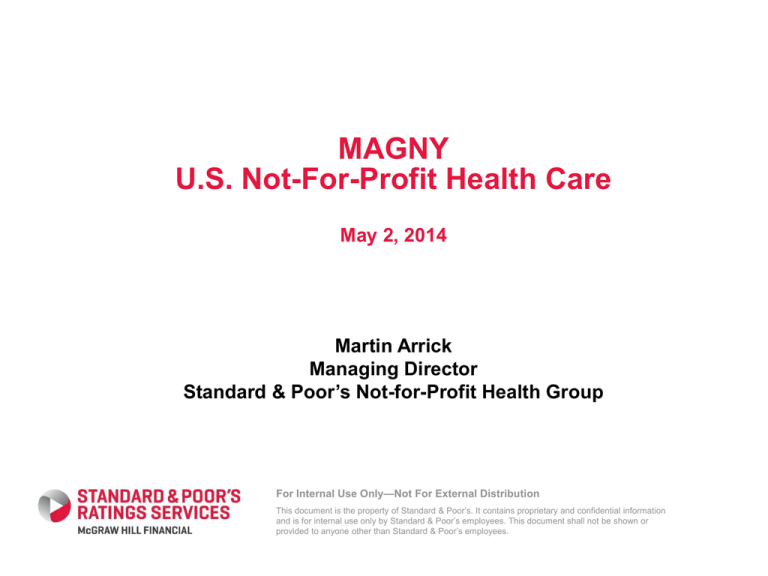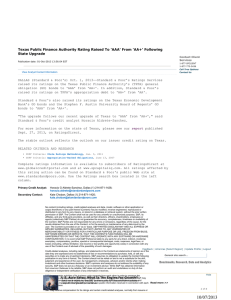
MAGNY
U.S. Not-For-Profit Health Care
May 2, 2014
Martin Arrick
Managing Director
Standard & Poor’s Not-for-Profit Health Group
For Internal Use Only—Not For External Distribution
This document is the property of Standard & Poor’s. It contains proprietary and confidential information
and is for internal use only by Standard & Poor’s employees. This document shall not be shown or
provided to anyone other than Standard & Poor’s employees.
U.S. Not-For-Profit Health Care: Our Sector Outlook – 2014
•
Growing negative pressures in the U.S. Not-For-Profit Health Care industry will drive
credit quality in the sector for the coming year, resulting in more downgrades than
upgrades in 2014
•
Organizations will find that the negative pressures weighing credit quality down will
outstrip their ability to implement sufficiently robust positive countermeasures
•
Even the strongest hospitals and health systems are, at best, only likely to hold
existing margin and reserve levels, while weaker providers will likely see ongoing
operating margin and cash flow erosion and eventually balance sheet pressure
leading to rating deterioration which has already begun and will continue in 2014.
Affordable Care Act
In 2014, we see a growing impact from the Affordable Care Act in
the S&P Health care Sectors, although the impact is less
pronounced than headlines suggested
Why?
• We’ve signaled since 2010 that the ACA would not have a big rating
impact
• Health care reform is evolving slowly
• Uncertainty about implementation (e.g. healthcare.gov)
• Recent lower than expected utilization has allowed health insurers to
strengthen their balance sheets
• Mixed and evolving concerns about narrow networks
3
Affordable Care Act: Not-For-Profit
Unlike insurance and for-profit, movement to health reform and
the Affordable Care Act is contributing to a more negative
environment for providers
Limited direct rating impact to–date, although tighter margins
and tighter credit quality… balance sheets remained strong
“How do we make it on Medicare rates?” Cost containment has
helped provider profitability – it is sustainable?
Exchanges could drive weaker commercial reimbursement – to
date marginal impact and not as dramatic as originally
anticipated
Contributor to declining utilization (value based purchasing
driver)
4
Declining Utilization
Then: due to the economy
Now: due to
• higher deductible plans; and
• the effort to address quality and utilization
Big debate as to why
We are forecasting higher competition in the provider space leading to
sluggish growth rates in the provider space and pressure on financial metrics
Significant movement from inpatient to shorter observation stays and
ambulatory settings
Greater use of pharmacology treatments as substitute for procedures
Shift of health care costs to patients (more copays, deductibles &coinsurance)
Deferred care due in part to growth in high deductible plans
Greater focus on quality and quality metrics leading to reduced utilization
5
Health Care Reform
Bending of the price curve starting to become apparent
• Getting sharper: starting to impact ratings and outlooks
• Pace is picking up
• Profitability pressure will continue to grow
• Providers are increasing efficiency
Value-based pricing and price transparency are big drivers but
are not yet apparent
At risk: high cost procedures and providers
Does high quality justify the cost?/ Role of tiering
6
Mergers & Acquisitions: Not-For-Profit
Merger and acquisition activity is expected to continue
Like for-profit providers, the need to build scale and
increase covered lives in preparation for new
reimbursement models
Health plan and hospital mergers and acquisitions
Growth in participation and affiliation strategies in lieu of
M&A
7
U.S. Not-For-Profit Health Care: Our Sector Outlook – 2014
and Beyond
Many substance and implementation issues surrounding reform, including:
• Who will populate the insurance exchanges?
• Will the surge of people with insurance in 2014 “flood” providers and boost labor markets? Will this be a
temporary issue?
• Longer-term, will inpatient volume plummet even further due to more effective prevention measures and
the advent of evidence-based medicine?
• Impact of local payor mixes will continue to influence view of reform – either positive or negative
• Continued political uncertainty
• Longer-term impact of Medicaid expansion (or lack of expansion)
• Longer-term impact of continued merger and integration within the industry
We believe implications of many of the above are likely to take at least a few years to settle in;
longer-term impact from reform may not be apparent until end of the decade
We believe even the strongest hospitals and health systems are, at best, only likely to hold
existing margin and reserve levels, while weaker providers will likely see ongoing operating
margin and cash flow erosion and eventually balance sheet pressure leading to rating
deterioration which has already begun and will continue in 2014.
Copyright © 2014 by Standard & Poor’s Financial Services LLC. All rights reserved.
No content (including ratings, credit-related analyses and data, valuations, model, software or other application or output therefrom) or any part thereof (Content) may be modified,
reverse engineered, reproduced or distributed in any form by any means, or stored in a database or retrieval system, without the prior written permission of Standard & Poor’s
Financial Services LLC or its affiliates (collectively, S&P). The Content shall not be used for any unlawful or unauthorized purposes. S&P and any third-party providers, as well as their
directors, officers, shareholders, employees or agents (collectively S&P Parties) do not guarantee the accuracy, completeness, timeliness or availability of the Content. S&P Parties
are not responsible for any errors or omissions (negligent or otherwise), regardless of the cause, for the results obtained from the use of the Content, or for the security or
maintenance of any data input by the user. The Content is provided on an “as is” basis. S&P PARTIES DISCLAIM ANY AND ALL EXPRESS OR IMPLIED WARRANTIES,
INCLUDING, BUT NOT LIMITED TO, ANY WARRANTIES OF MERCHANTABILITY OR FITNESS FOR A PARTICULAR PURPOSE OR USE, FREEDOM FROM BUGS,
SOFTWARE ERRORS OR DEFECTS, THAT THE CONTENT’S FUNCTIONING WILL BE UNINTERRUPTED OR THAT THE CONTENT WILL OPERATE WITH ANY SOFTWARE
OR HARDWARE CONFIGURATION. In no event shall S&P Parties be liable to any party for any direct, indirect, incidental, exemplary, compensatory, punitive, special or
consequential damages, costs, expenses, legal fees, or losses (including, without limitation, lost income or lost profits and opportunity costs or losses caused by negligence) in
connection with any use of the Content even if advised of the possibility of such damages.
Credit-related and other analyses, including ratings, and statements in the Content are statements of opinion as of the date they are expressed and not statements of fact. S&P’s
opinions, analyses and rating acknowledgment decisions (described below) are not recommendations to purchase, hold, or sell any securities or to make any investment decisions,
and do not address the suitability of any security. S&P assumes no obligation to update the Content following publication in any form or format. The Content should not be relied on
and is not a substitute for the skill, judgment and experience of the user, its management, employees, advisors and/or clients when making investment and other business decisions.
S&P does not act as a fiduciary or an investment advisor except where registered as such. While S&P has obtained information from sources it believes to be reliable, S&P does not
perform an audit and undertakes no duty of due diligence or independent verification of any information it receives.
To the extent that regulatory authorities allow a rating agency to acknowledge in one jurisdiction a rating issued in another jurisdiction for certain regulatory purposes, S&P reserves
the right to assign, withdraw or suspend such acknowledgement at any time and in its sole discretion. S&P Parties disclaim any duty whatsoever arising out of the assignment,
withdrawal or suspension of an acknowledgment as well as any liability for any damage alleged to have been suffered on account thereof.
S&P keeps certain activities of its business units separate from each other in order to preserve the independence and objectivity of their respective activities. As a result, certain
business units of S&P may have information that is not available to other S&P business units. S&P has established policies and procedures to maintain the confidentiality of certain
non-public information received in connection with each analytical process.
S&P may receive compensation for its ratings and certain analyses, normally from issuers or underwriters of securities or from obligors. S&P reserves the right to disseminate its
opinions and analyses. S&P's public ratings and analyses are made available on its Web sites, www.standardandpoors.com (free of charge), and www.ratingsdirect.com and
www.globalcreditportal.com (subscription), and may be distributed through other means, including via S&P publications and third-party redistributors. Additional information about our
ratings fees is available at www.standardandpoors.com/usratingsfees.
STANDARD & POOR’S, S&P, GLOBAL CREDIT PORTAL and RATINGSDIRECT are registered trademarks of Standard & Poor’s Financial Services LLC.






